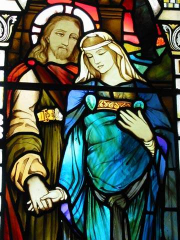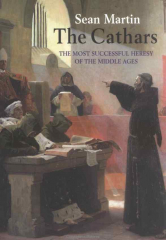“What is known as the Cathar Religion flourished in the full light of day, for a very brief period. It was first identified as a heresy by the church in 1150; was deprived of the protection of the lords of Occitan in 1210, subjected to one hundred years of the inquisition and finally eradicated, with the burning at the stake of the last Perfect, Guilliaume Belibaste in 1310.”
Well… no!
An Amalgam
 Very little is known about the Cathar faith which can be subjected to the normal academic proof of veracity.
Very little is known about the Cathar faith which can be subjected to the normal academic proof of veracity.What we can surmise is that it had very early beginnings, before the birth of Jesus. It is an amalgam of the earlier religions of Egypt, Persia, Sumer and India. The message was unified, simplified and made available to all by the teaching of Jesus and Magdalene.
Wide Distribution
 Very little is known about the Cathar faith which can be subjected to the normal academic proof of veracity.
What we do know is that it had very early beginnings, before the birth of Jesus. It is an amalgam of the earlier religions of Egypt, Persia, Sumer and India. The message was unified, simplified and made available to all by Jesus teaching.
The Church of Rome, determined to protect the Jewish heritage, adopted some of this alternative religion and tried to obscure the differences. The Emperor Constantine in allowing the Church of Rome to prosper failed to recognise these differences.
"Heracy" quickly changed in meaning from "different opinion" to "crime against faith".
In order to avoid recognition of the true strength of the alternative faith, the Church of Rome gave the faith a different name in all the territories in which it occured stressing different aspects of the teaching in each place.The Cathar church had no possessions, no grand churches or bejewelled vestments, no ritual, ceremonies, sacraments or pagentry.
Very little is known about the Cathar faith which can be subjected to the normal academic proof of veracity.
What we do know is that it had very early beginnings, before the birth of Jesus. It is an amalgam of the earlier religions of Egypt, Persia, Sumer and India. The message was unified, simplified and made available to all by Jesus teaching.
The Church of Rome, determined to protect the Jewish heritage, adopted some of this alternative religion and tried to obscure the differences. The Emperor Constantine in allowing the Church of Rome to prosper failed to recognise these differences.
"Heracy" quickly changed in meaning from "different opinion" to "crime against faith".
In order to avoid recognition of the true strength of the alternative faith, the Church of Rome gave the faith a different name in all the territories in which it occured stressing different aspects of the teaching in each place.The Cathar church had no possessions, no grand churches or bejewelled vestments, no ritual, ceremonies, sacraments or pagentry.
Its litargy was sparse and there was no formal heirachy organised on a geographical basis.The Church of Rome, determined to protect the Jewish heritage, adopted some of this alternative religion and tried to obscure the differences. The Emperor Constantine in allowing the Church of Rome to prosper failed to recognise these differences.”Heresy” quickly changed in meaning from “different opinion” to “crime against faith”.
In order to avoid recognition of the true strength of the alternative faith, the Church of Rome gave the faith a different name in all the territories in which it occurred stressing different aspects of the teaching in each place.
The Council
 The Albigensian Crusade may well have been triggered by a meeting of Cathar Church leaders from many different geographical locations. The meeting took place at St Felix en Lauragais in 1167. There, for a brief moment the Cathars showed that there was a unified structure however informal. There was a hint that above the Perfects the was at least one more level, possibly several levels. It was no more than a hint because there were no material possessions, and no self aggrandisement to distinguish position.
The Albigensian Crusade may well have been triggered by a meeting of Cathar Church leaders from many different geographical locations. The meeting took place at St Felix en Lauragais in 1167. There, for a brief moment the Cathars showed that there was a unified structure however informal. There was a hint that above the Perfects the was at least one more level, possibly several levels. It was no more than a hint because there were no material possessions, and no self aggrandisement to distinguish position.
Modern Folklore
 The poem “Jerusalem” by William Blake was adopted by the 19th century feminist movement and set to music by Parry as a theme song for the women’s suffrage movement. Edward Elgar then elevated it to an orchestral piece and since 1922 has been an ever-present element at the last night of the Proms.
The poem “Jerusalem” by William Blake was adopted by the 19th century feminist movement and set to music by Parry as a theme song for the women’s suffrage movement. Edward Elgar then elevated it to an orchestral piece and since 1922 has been an ever-present element at the last night of the Proms.
Another Christianity
 OLYMPUS DIGITAL CAMERAThough a relatively modern piece it essentially asks the Question “ Did Jesus visit England?” and the significance of it’s adoption by the suffragette movement was the suggestion that there might be another Christianity; one which was much more sympathetic towards women! If Jesus really did walk the “mountains green” 2000 years ago, then it must have been before the year 30, perhaps fifteen years before the Roman invasion and occupation of Britain was commenced. ( Julius Caesar knew Britain was there, but he didn’t conquer it , that achievement fell to the Emperor Claudius.
OLYMPUS DIGITAL CAMERAThough a relatively modern piece it essentially asks the Question “ Did Jesus visit England?” and the significance of it’s adoption by the suffragette movement was the suggestion that there might be another Christianity; one which was much more sympathetic towards women! If Jesus really did walk the “mountains green” 2000 years ago, then it must have been before the year 30, perhaps fifteen years before the Roman invasion and occupation of Britain was commenced. ( Julius Caesar knew Britain was there, but he didn’t conquer it , that achievement fell to the Emperor Claudius.
Another Religion
Fast forward to 376. In the east, sitting outside the Roman Empire were the Germanic peoples, Goths, Vandals and Alans to the North East. Persians and Assyrians to the east, Arabs and Indians to the South East and Egyptians to the South. All these areas absorbed Jesus teaching and allowed it to flourish but with significant differences in interpretation. Some of these interpretations were so different they could hardly be considered the same religion.
The Goths
The Gothic religion was labeled by the Church of Rome as “Arian” but it was more than that. The Goths absorbed the original Arian thinking that if Jesus was indeed the son of god, then at some time he must have not existed, he must have been created just like the rest of us. He might well be considered human. A good man but just a man.
Manichism
Gothic beliefs also incorporated the teachings of Mani. Manichaeist beliefs had thrived beyond the eastern boundary of the Roman Empire. In Manichaeism there were two Gods, a Good God called simply God, Good God, Pleroma, Bythos, Amun or Mazda and a Bad God, Demoniac, Demiurge or Yahweh.
